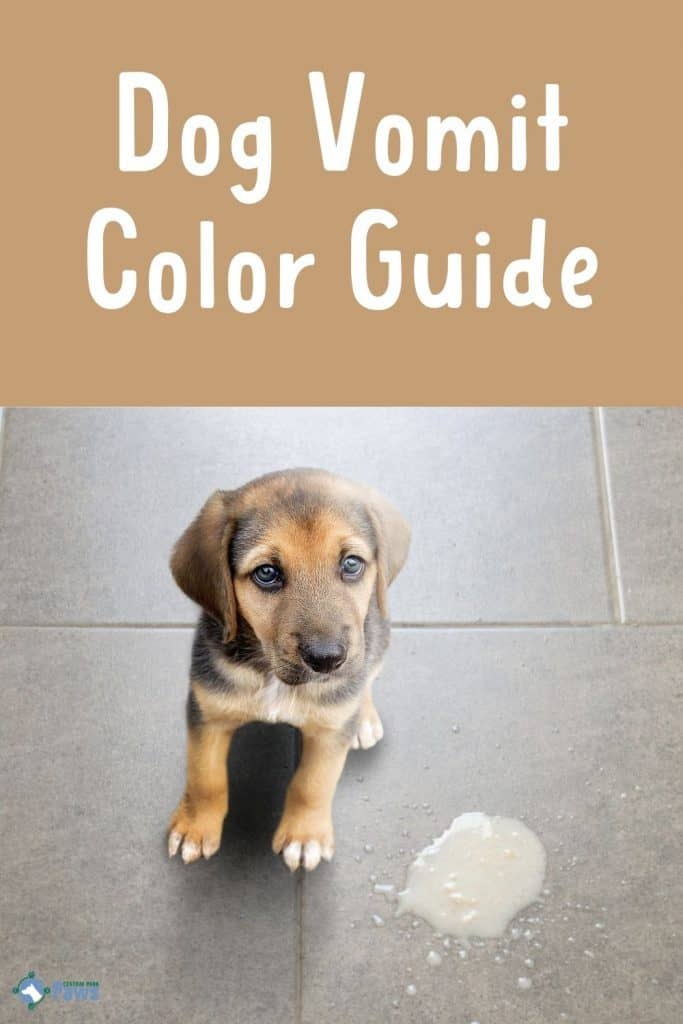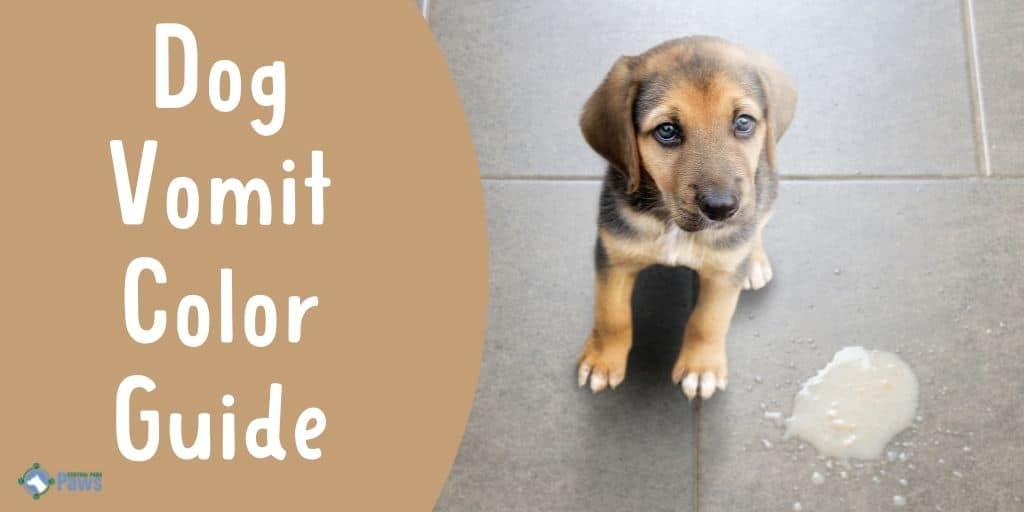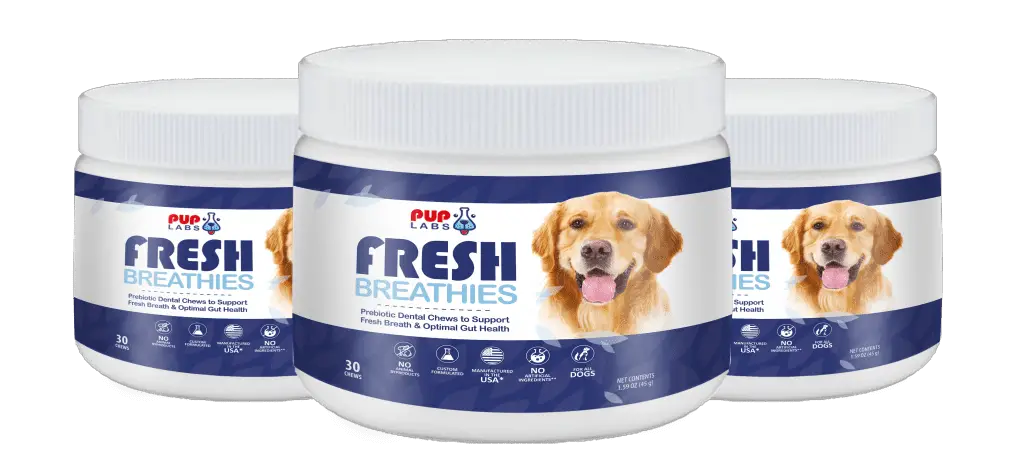This past weekend while camping with the family, Ginger got sick shortly after eating breakfast.
I was mildly concerned about Ginger getting sick, but not rush to the emergency room worried. Most of what she had vomited up was her breakfast, but she hadn’t just regurgitated either.
Long story short, she was fine; we ended up hiking nine miles later that day.
Ginger has a history of getting sick in the mornings, and it’s been something we have dealt with for years. However, we always observe her for changes to ensure we don’t miss any new symptoms.
When your dog vomits, it can be challenging to know if you should wait and see, give them something in the attempt to make them feel better, or rush them to the vet office.
The good news is that the color and consistency of dog vomit can tell you a lot about how your dog is feeling, which can help determine whether or not they need to get to the vet hospital as soon as possible.
Dog Vomit Colors and What They Mean
When first looking at your dog’s vomit, it is good to ask yourself what color their food, treats, and chews are since that often impacts the color of their vomit.
Also, when cleaning up dog vomit, it is best to use a plain white paper towel so you can see the actual color since the floor color can impact how it initially looks.
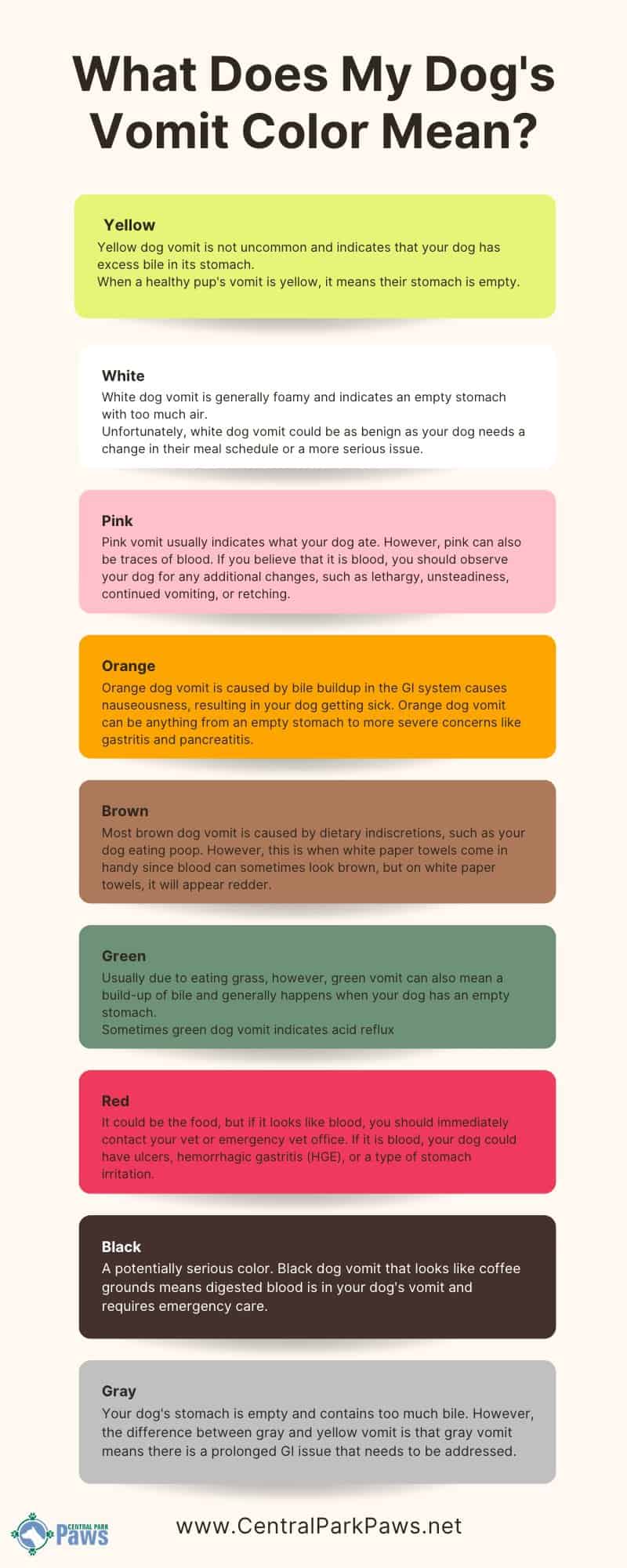
Yellow Dog Vomit
Yellow dog vomit is not uncommon and indicates that your dog has excess bile in its stomach[1].
When a healthy pup’s vomit is yellow, it means their stomach is empty.
Ginger used to get vomit yellow bile in the mornings if she ate dinner too early. We pushed her dinner out a bit, and the problem went away.
But, if your pup vomits yellow bile regularly, it would be best to contact your vet to see if something more serious is going on, such as acid reflux, gastritis, or intestinal blockage[2].
White Dog Vomit
White dog vomit is generally foamy and indicates an empty stomach with too much air[3].
Unfortunately, white dog vomit could be as benign as your dog needs a change in their meal schedule or a more serious issue.
Some of the more concerning issues that are associated with white dog vomit include bloat and pancreatitis.
Pink Dog Vomit
Pink vomit usually indicates what your dog ate. However, pink can also be traces of blood[4].
If you believe that it is blood, you should observe your dog for any additional changes, such as lethargy, unsteadiness, continued vomiting, or retching.
If your dog displays additional symptoms, you should contact your vet’s office.
Orange Dog Vomit
What does orange dog vomit mean?
Orange dog vomit has the same causes as yellow vomit. Bile buildup in the GI system causes nauseousness, resulting in your dog getting sick.
Orange dog vomit can be anything from an empty stomach to more severe concerns like gastritis and pancreatitis, both of which require medical attention.
If your dog’s vomit is orange, you can keep an eye on them to see if they worsen or recover. Some red flags to look for include stumbling, drooling, muscle weakness, and continued vomiting.
Brown Dog Vomit
Unfortunately, most brown dog vomit is caused by dietary indiscretions, such as your dog eating poop.
If your dog’s vomit is brown and absolutely foul smelling, you can be pretty confident your dog ate poop and is ridding it from their body.
If it is poop, you may want to consider a coprophagia supplement to deter your dog from eating poop. To learn more about coprophagia supplements, click here.
However, this is when white paper towels come in handy since blood can sometimes look brown, but on white paper towels, it will appear redder.
Green Dog Vomit
Green dog vomit usually means your dog has been out grazing and eating grass. Most green dog vomit has bits of grass in it, making it easy to determine what caused your dog to get sick.
However, green vomit can also mean a build-up of bile and generally happens when your dog has an empty stomach.
Sometimes green dog vomit indicates acid reflux, which your vet can help you diagnose.
Red Dog Vomit
Red dog vomit is one of the most unsettling sights a dog parent may witness, and I am speaking from personal experience.
When Sophie was younger, she was vomiting blood, and it was one of the scariest things I’ve ever seen. The good news was after receiving emergency care, for hemorrhagic gastritis, she was fine.
Of course, if your dog’s food is reddish in color, it could be the food, but if it looks like blood, you should immediately contact your vet or emergency vet office.
If it is blood, your dog could have ulcers, hemorrhagic gastritis (HGE), or a type of stomach irritation.
Black Dog Vomit
Black dog vomit is another potentially serious color. Black dog vomit that looks like coffee grounds means digested blood is in your dog’s vomit and requires emergency care[5].
However, a more benign reason for black vomit could be that your dog was eating dirt or soil.
It isn’t uncommon for dogs to eat dirt or soil from time to time, especially organic soil that contains blood and bone meal.
Gray Dog Vomit
You may be asking yourself, why is my dog’s vomit gray?
Gray dog vomit is another indicator your dog’s stomach is empty and contains too much bile.
However, the difference between gray and yellow vomit is that gray vomit means there is a prolonged GI issue that needs to be addressed.
If your dog’s vomit is gray, you will want to contact your local vet and get them seen soon.
Dog Vomit Types
In addition to color, the consistency of your dog’s vomit is equally as important as the color and will help you determine what is making your dog sick.
Chunky Dog Vomit
Chunky dog vomit can range from the whole kibble to oatmeal.
Chunky vomit might mean anything from a simple upset stomach that will soon pass or that your dog is unable to pass food as normal.
Frequently, dogs who can’t pass food are suffering from an intestinal blockage.
Dogs with intestinal blockages need to be seen as soon as possible; some other symptoms you might see if there is a blockage include:
- Diarrhea
- Weakness
- Bloating
- Abdominal Pain
- Loss of Appetite
- Whining
- Hunching
- Unable to keep anything down, including water
Liquid Dog Vomit
Clear liquid vomit is similar to foamy white vomit and means your dog’s stomach is empty.
Liquid vomit could be caused by your dog drinking water but being unable to keep anything down, such as a GI blockage.
Or it may be as simple as your dog drinking water too fast and regurgitating it.
Slimy Mucus Vomit
Slimy mucus vomit is frequently accompanied by drooling and indicates a serious stomach irritation.
If your dog’s vomiting and drooling, it is vital to get your dog to the vet right away.
Foreign Object Vomit
When referring to a foreign object, it can be anything like foods that are hard to digest, toys, socks, really anything that isn’t approved dog food or treats.
If your dog vomits a foreign object, it is essential to keep an eye on your dog to ensure no damage was done to your dog’s GI system, either when the item was consumed or when it came up.
Did Your Dog Actually Vomit?
Not everything that comes up is considered vomit.
There is a difference between vomiting and regurgitation or coughing something up, and it is essential to know which is which.
Dog Vomiting vs Regurgitation
Regurgitation looks a lot like vomit, but the big difference is when it comes out.
The timing of when your dog consumes what comes up is the best way to determine if your dog has regurgitated or if they vomited.
Regurgitation happens shortly after your dog eats or drinks and regurgitated food looks similar to how it went down.
Also, regurgitated food has not made it to the stomach and will come up quickly and with little effort.
And when your dog vomits, it comes from the abdomen, and the vomiting process is more prolonged and is accompanied by retching.
Usually, regurgitation does not require medical attention since it is caused by your dog eating too fast.
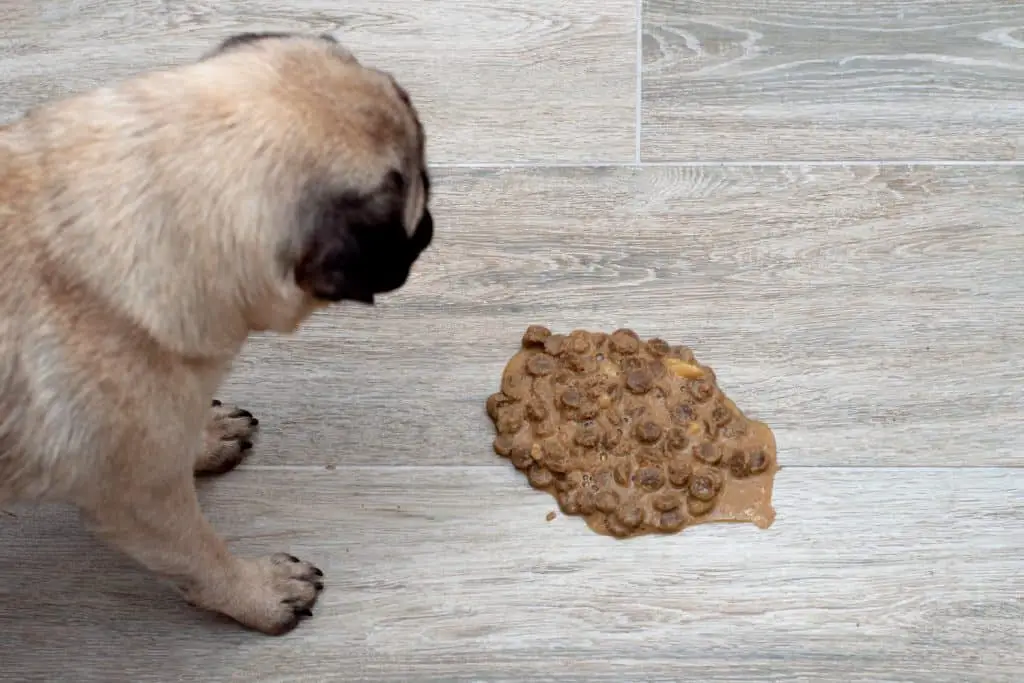
Coughing vs Vomiting
Dogs who have a terrible cough will sometimes cough up small amounts of liquid.
If your dog has a coughing fit, they may also make a lot of lip-licking or smacking noises.
Dogs generally do not cough without reason, so if your dog has multiple coughing episodes or is accompanied by discharge from the eyes or nose, it is crucial to get your dog to the vet.
Dog’s with a serious cough can indicate an upper respiratory infection.
When Should You Be Concerned?
No one wants to be an alarmist, nor do people want to be the parent that overlooks something more serious.
When a dog gets sick, it is not always a reason to be worried. However, there are some additional indicators that will help you know when to call the vet for your dog:
- Lethargic
- Loss of appetite
- Continued vomiting
- Depressed
- Diarrhea
- Dehydration
- Weakness
- Drooling
- Abdominal pain
- Abdominal bloating
If you are ever in doubt about whether to bring your dog in or not, call the vet and ask.
How to Treat Dog Vomiting
Home Remedies For Vomiting Dogs
The best thing to do for your pup who has gotten sick is to fast them for 24-hours.
You can continue to offer water to avoid dehydration, but avoid giving your dog food or treats until their stomach can settle.
When your dog can eat again, you can offer small amounts of food. Also, it is best to feed a bland diet of ground turkey or beef and rice.
And if your canine has allergies, you can use potatoes instead of rice and any low-fat ground meat.
Over the Counter Medications
Though there are some safe over-the-counter medications you can give your dog, it is best to hold off on giving your dog any medications before consulting your vet.
Vomiting isn’t always something serious, but it can be a symptom of something worse, and you don’t want to mask symptoms and miss anything.
Causes Of Vomiting In Dogs
There is a wide variety of reasons your dog is vomiting, things such as:
- Diet-related causes – Like food intolerances, change in diet,
- Environmental Causes – Motion sickness, eating foreign objects, toxins, parasites, or medications like flea and tick preventatives, Cyclosporine, and anti-inflammatories.
- Health-related causes – There are several illnesses that cause vomiting, such as pancreatitis, diabetes, irritable bowel disease, liver disease, kidney disease, hemorrhagic gastroenteritis, infection, Cushing’s disease, and Addison’s disease
FAQs
What color dog vomit is the most serious?
All dog vomit, regardless of color, is a reason to keep an eye on your pup; however, black vomit that looks like coffee grounds and bright red are the most urgent colors, and you should get your dog to the vet immediately.
But that does not mean you should dismiss the other colors either; deadly situations such as bloat do not usually cause red or black vomit, but instead colors associated with bile.
What does black dog vomit mean?
Black dog vomit can mean anything from your dog eating dirt to blood in your dog’s GI system.
What does bright red bloody vomit mean?
Red bloody vomit needs to be addressed immediately; it can mean your dog has ulcers, HGE, or other GI irritation.
Resources
- https://www.petcarerx.com/article/dog-vomiting-mucus-heres-why-and-what-you-can-do-about-it/1349#:~:text=Bile%E2%80%94usually%20a%20yellow%20or,%2C%20diabetes%2C%20and%20kidney%20failure.
- https://www.petmd.com/dog/general-health/5-reasons-why-your-dog-throwing-bile
- https://blog.myollie.com/dog-throwing-up-foam/#:~:text=The%20most%20common%20reason%20for,pale%2C%20frothy%20liquid%20or%20foam.
- https://www.hillspet.com/dog-care/healthcare/dog-vomiting-blood
- https://www.animalwised.com/my-dog-vomited-black-liquid-3697.html
